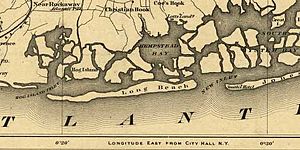Hog Island (New York) facts for kids

Hog Island was the name for two different islands near Long Island, New York. They were called this until the 1890s. One of these islands is now known as Barnum Island. It includes the villages of Island Park and Harbor Isle in Nassau County. The other Hog Island was a barrier island about a mile long. It was located south of Rockaway Beach in Queens. This island was mostly destroyed by a big storm in 1893. By 1902, it had completely disappeared due to erosion and more storms.
Contents
Barnum Island: The First Hog Island
The island now known as Barnum Island was once called "Hog Island." Native Americans used it to raise pigs. These pigs had been brought by Europeans and then left to live in the wild. Later, the island became a small farming area.
In 1874, a woman named Sarah Ann Baldwin Barnum bought the land. She was not related to the famous showman P. T. Barnum. Business people were planning to buy the land for a lot of money. But Sarah Ann convinced the owner to sell it to her instead. She wanted to use it as a working farm. This farm would help and employ poor people. She bought the land with her own money. Then she immediately sold it to the Queens County government for the same price. At that time, Nassau County was part of Queens.
In 1898, the county closed the almshouse, which was a home for poor people. They sold the property to land developers for $40,000.
In 1926, a large part of the island became the Village of Island Park. The rest of the island is still not part of a village. The northeast part is still called Barnum Island. The western part is known as Harbor Island. All three areas are part of the Town of Hempstead.
The Lost Hog Island of Rockaway
How the Island Formed and Grew
Ocean currents slowly built up a large sandbar. Reports suggest that this sandbar began to appear from the ocean during the American Civil War (1861-1865). It was about 1,000 feet south of the Rockaway shore. Over time, it grew to be about a mile long. It was also several hundred feet wide. Because it was shaped like a hog's back, it became known as Hog Island. Sometimes it was also called Far Rockaway Beach Island.
A Popular Resort Spot
The island became popular with people who wanted to build beach resorts. It had places for fun, swimming, restaurants, and saloons. It was a favorite place for politicians from Tammany Hall to meet. Many important decisions, sometimes called "backroom deals," were actually made out in the open air on this island.
The Great Storm of 1893
A winter storm in early 1893 caused a lot of damage to the island. Later that year, in late August 1893, several hurricanes were active in the Atlantic Ocean. On August 22, 1893, strong waves covered Hog Island. This reduced its size, but the island was still mostly there.
The next evening, a very powerful hurricane hit New York City. It lasted from Wednesday evening until Thursday morning. Waves as high as 30 feet were reported at Coney Island. These waves reached far inland, destroying a train track there. The East River also flooded over its wall in the Astoria area. Water was waist-high in the streets of Brooklyn.
Most of Hog Island disappeared during this storm. News reports told stories of dramatic rescues from the island.
The Island's Final Disappearance
After the 1893 storm, some new buildings were put up on the smaller Hog Island. But it was damaged again in another storm in 1896. It is believed that the island completely disappeared due to erosion by 1902.
Finding Clues from the Past
In the mid-1990s, big storms in December 1992 and March 1993 heavily damaged the Rockaway coast. The United States Army Corps of Engineers began to rebuild the Rockaway Peninsula beaches. They used sand dug up from close to the shore.
Professor Nicholas Coch from Queens College and his students were watching this work. They noticed strange items along the coast. The group found hundreds of different objects. These included old whiskey bottles, beer mugs, and even a hurricane lamp. Most of these items were from the late 1800s. Professor Coch believes they came from Hog Island. However, he also says they could be from other nearby resort areas damaged by the 1893 storm.
The Queens College group became curious about their findings. They started to learn more about the history of Hog Island. Their research also helped scientists understand more about how often major hurricanes hit the New York City area.

